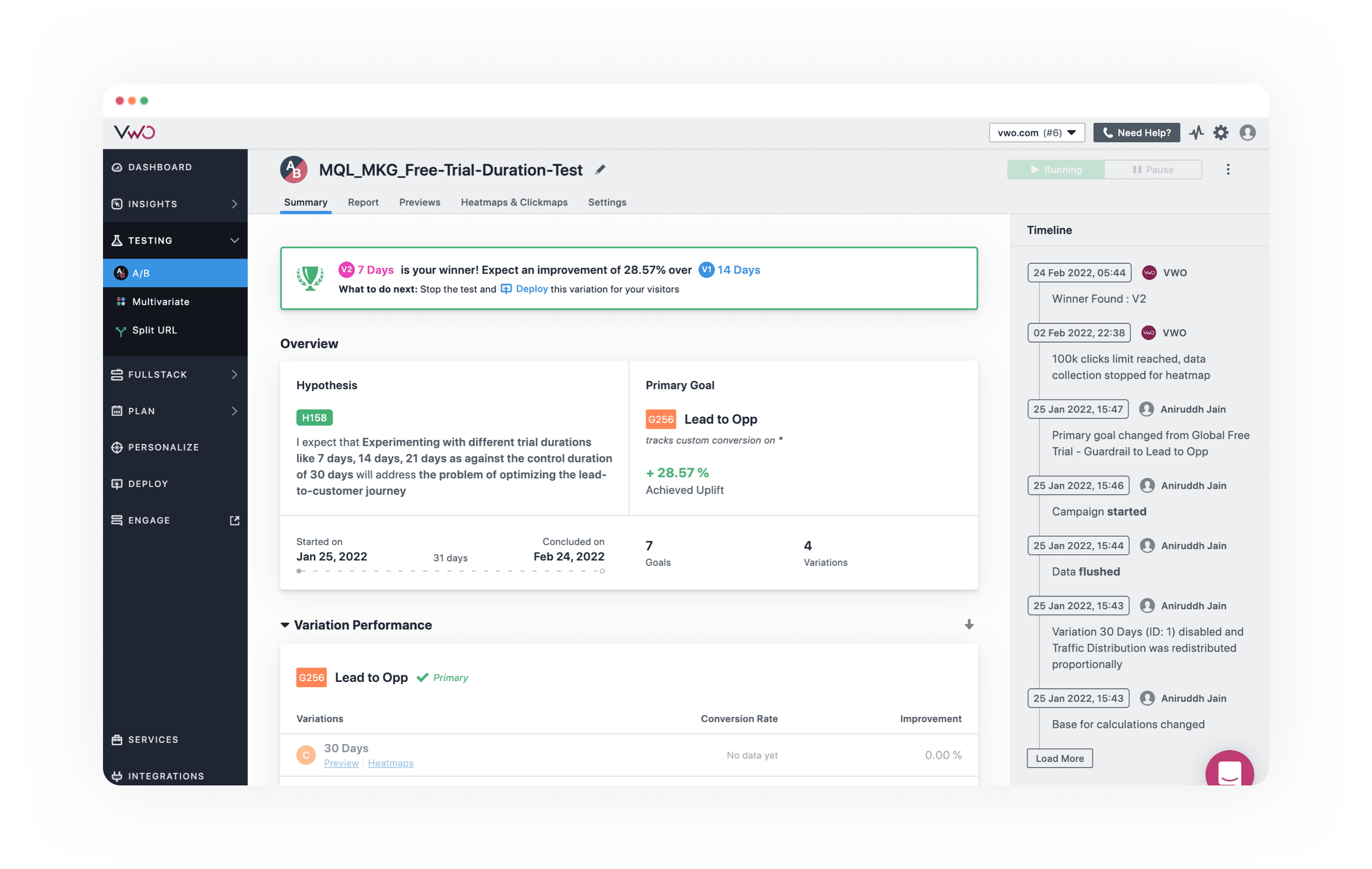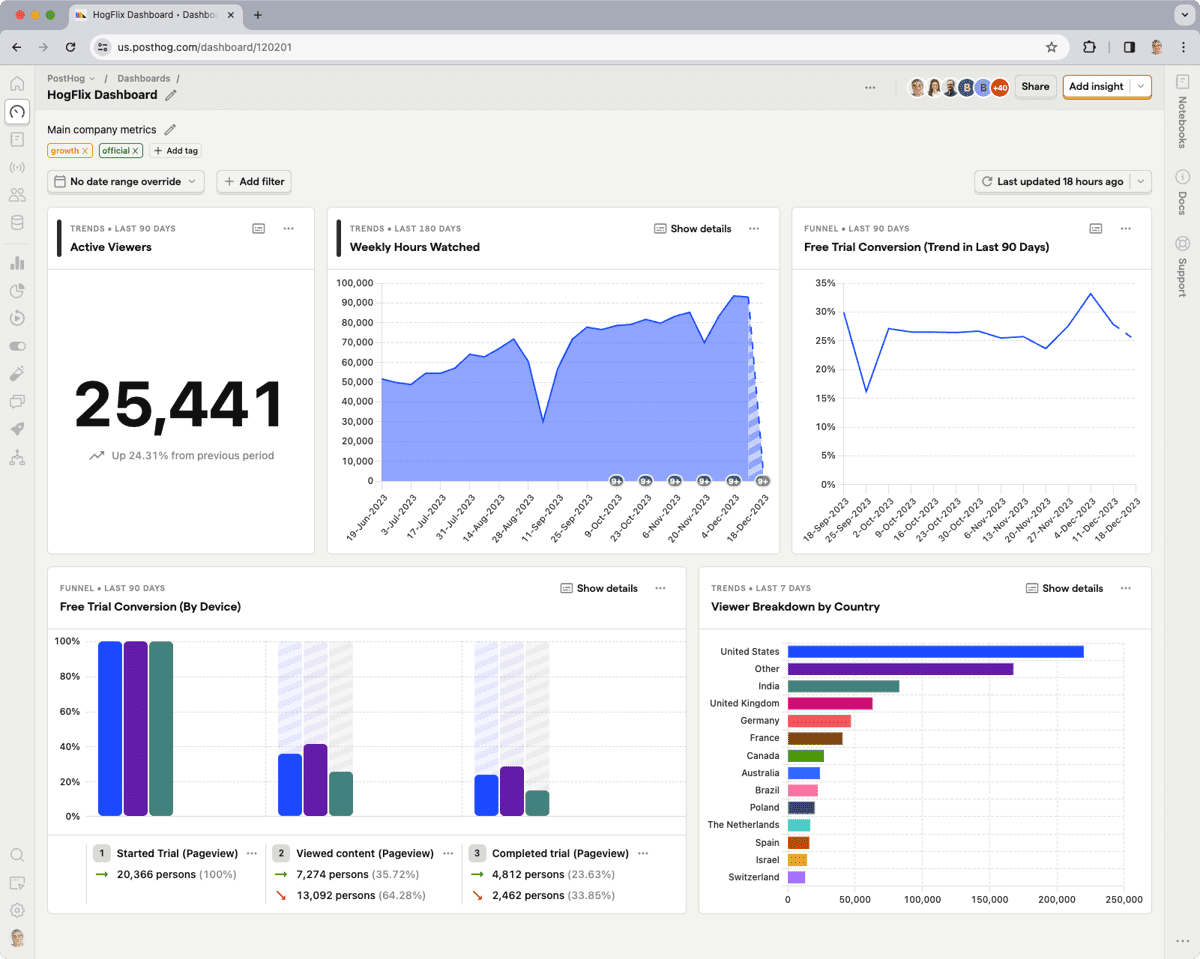Are you looking to optimize your website's performance but unsure if VWO is the right choice? You're in luck! We've compiled...

How to Prevent Funnel Drop With User Behavior Tools
Funnel drop or funnel abandonment means users drop out of your conversion funnel at different points and fail to complete your desired action. To understand what prevents them from becoming paying customers, you can use user behavior tools like our FullSession.
We provide you with session recordings and replays to observe how users navigate your site, interactive heatmaps to assess which page elements are the least engaging, and website feedback forms to get additional context by asking customers about their experience. With FullSession, you can create a funnel and monitor results for each customer journey stage.
Sign up right now to check our platform during a 14-day trial or schedule a demo to see it in action.
If you want to know how to prevent funnel drops with user behavior tools, read on! We’ll take you through every important detail you need to know to eliminate obstacles that lead to funnel abandonment.
What is the purpose of a funnel in the conversion process?
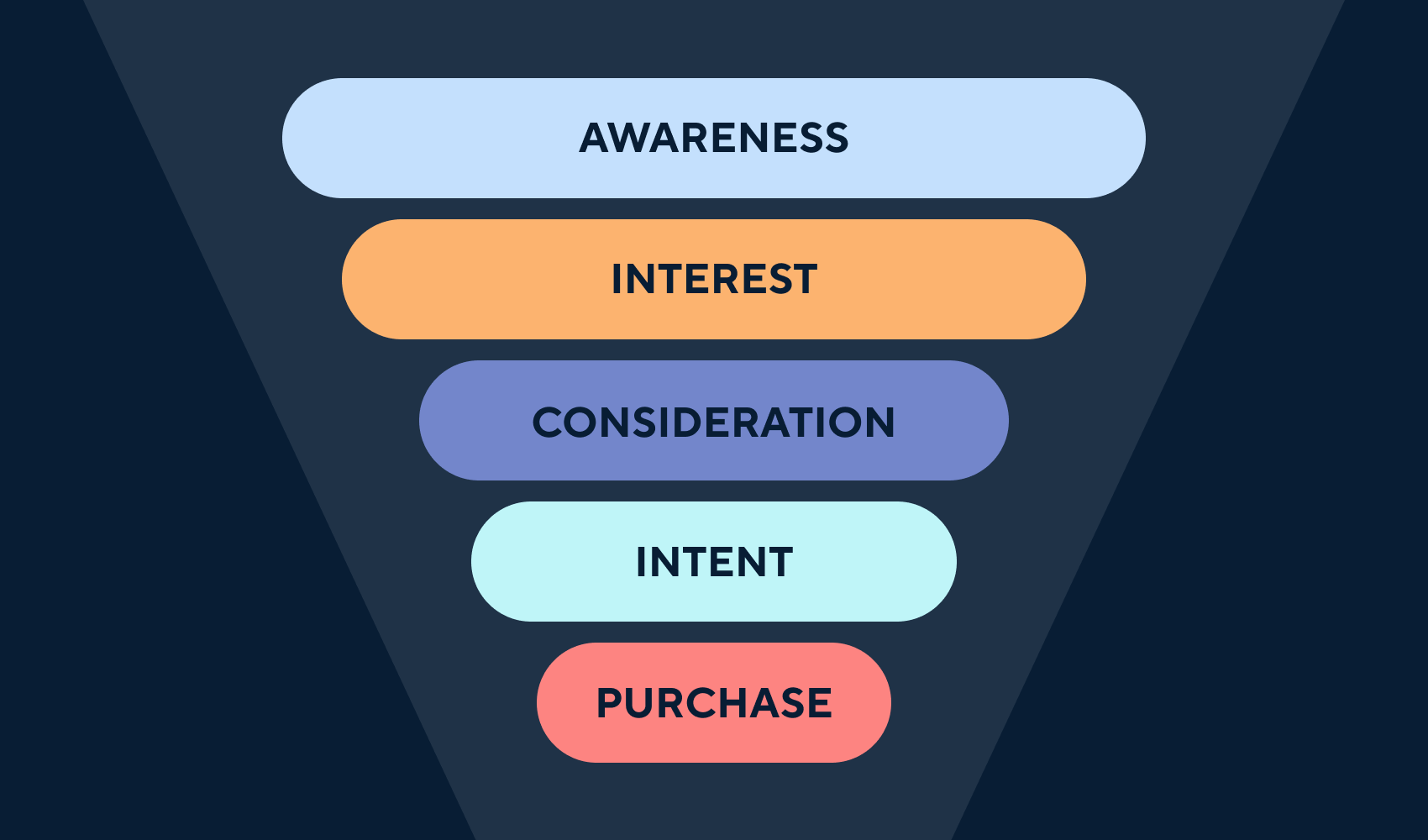
Image source: Intercom
Funnels are essential to the conversion process. They help you visualize the customer journey from initial awareness to purchase, providing valuable insight into how customers interact with your website, products, or services.
Marketers typically use funnels to strategically nurture prospects and move them closer to making a purchase decision. Funnels also provide data-driven insights on which channels and tactics are most effective at driving conversions.
By tracking and analyzing this data, marketers can optimize their strategies for better results.
What is a funnel analysis?
Funnel analysis is a process of monitoring and analyzing users' activity on a website or application to identify any potential problems or bottlenecks hindering their progress on the path to conversion.
It maps out user behavior at different stages of the customer journey. It helps you measure the effectiveness of email, search engine, and social media marketing campaigns, evaluate which strategies are working best and adjust your efforts accordingly to increase conversions.
Four types of funnels you should know about
There are four types of conversion funnels you should be aware of to maximize your website potential.
- Goal funnel – the first type is the goal funnel. It includes a step-by-step process that leads to achieving a specific, usually non-transactional goal, like a newsletter sign-up.
- Sales funnel – it’s similar to the goal funnel but focused on the sales process and sales-related activities, like ordering a product or subscribing to a service.
- Strict funnel – this is the funnel you use to get people to follow a strict chain of actions you designed with a specific goal in mind – visitors can’t skip any of the steps. You can use these funnels to identify problems that lead people to drop off because you see which actions cause issues.
- Flexible funnel – the fourth type of funnel is the opposite of a strict funnel. You don’t restrict or limit user interactions on your website and analyze different approaches they take.
Each of these funnels is important; you should analyze them to ensure you get the most out of your website. But how to conduct such an analysis?
Three crucial steps to conduct a funnel analysis
Funnel analysis is a great way to track user behavior and identify opportunities for improvement. Here are the three crucial steps you should keep in mind.
- Define the funnel: The first step in conducting a funnel analysis is clearly defining the user journey and the critical steps along the way. It includes identifying the entry points, user actions within the funnel, and the outcome or goal.
- Gather funnel metrics: Once you define the funnel, the next step is to measure the performance of each step users take on their journey. You can track metrics such as time spent on each page, conversions, and abandonment rates, to name a few.
- Analyze and optimize the funnel: The final step is to analyze the data and identify improvement areas. It could include making changes to the design or content of the page, improving the user experience, or testing different strategies.
But why should you even analyze your funnels in the first place? Let’s look at the possible benefits of funnel analysis.
Seven critical benefits of funnel analysis
Funnel analysis is an invaluable tool for businesses that lets you
- Identify the sources of website traffic
- Identify the most effective marketing channels
- Understand users’ behavior and preferences
- Identify bottlenecks in the user journey
- Optimize conversion rates at each stage of the funnel
- Improve ROI through targeted campaigns
- Measure the impact of changes
To reap the benefits of your funnel analysis, you must optimize your funnels to eliminate drop-off points.
What is a funnel drop?
A funnel drop is when a user abandons a conversion process. In essence, it means you lose a potential client resulting in lost profit. Funnel drop-off often happens due to a problem on your website, but there can also be other reasons. Let’s discuss them.
Three key reasons behind funnel drop and low conversion rate

Image source: Freepik
A low conversion rate can be frustrating, especially if you've invested time and money into building your website, web app, or landing page.
Understanding why people are leaving your website without converting can help you figure out how to improve it, so let’s look at the critical reasons for a high funnel drop-off rate and low conversion rates.
1. Lack of clarity
If customers need help understanding your product or why they should buy it, they will likely leave your site resulting in huge drop-off rates. To overcome this challenge, use visuals and simple language, and ensure your website is easy to use and comprehend.
2. Attracting the wrong audience
Another reason for funnel drop-off is not targeting the right people. Identify the best audience for your products and plan your layout, content, and communication strategy accordingly.
3. Website issues
Finally, customers will likely leave if your website is slow or hard to navigate. Make sure load times are quick, and optimize your information architecture to ensure customers find necessary information quickly.
You can increase conversions and grow your business with the proper adjustments and planning. However, you won’t get far if you can’t track your progress.
Funnel tracking and reporting with Google Analytics
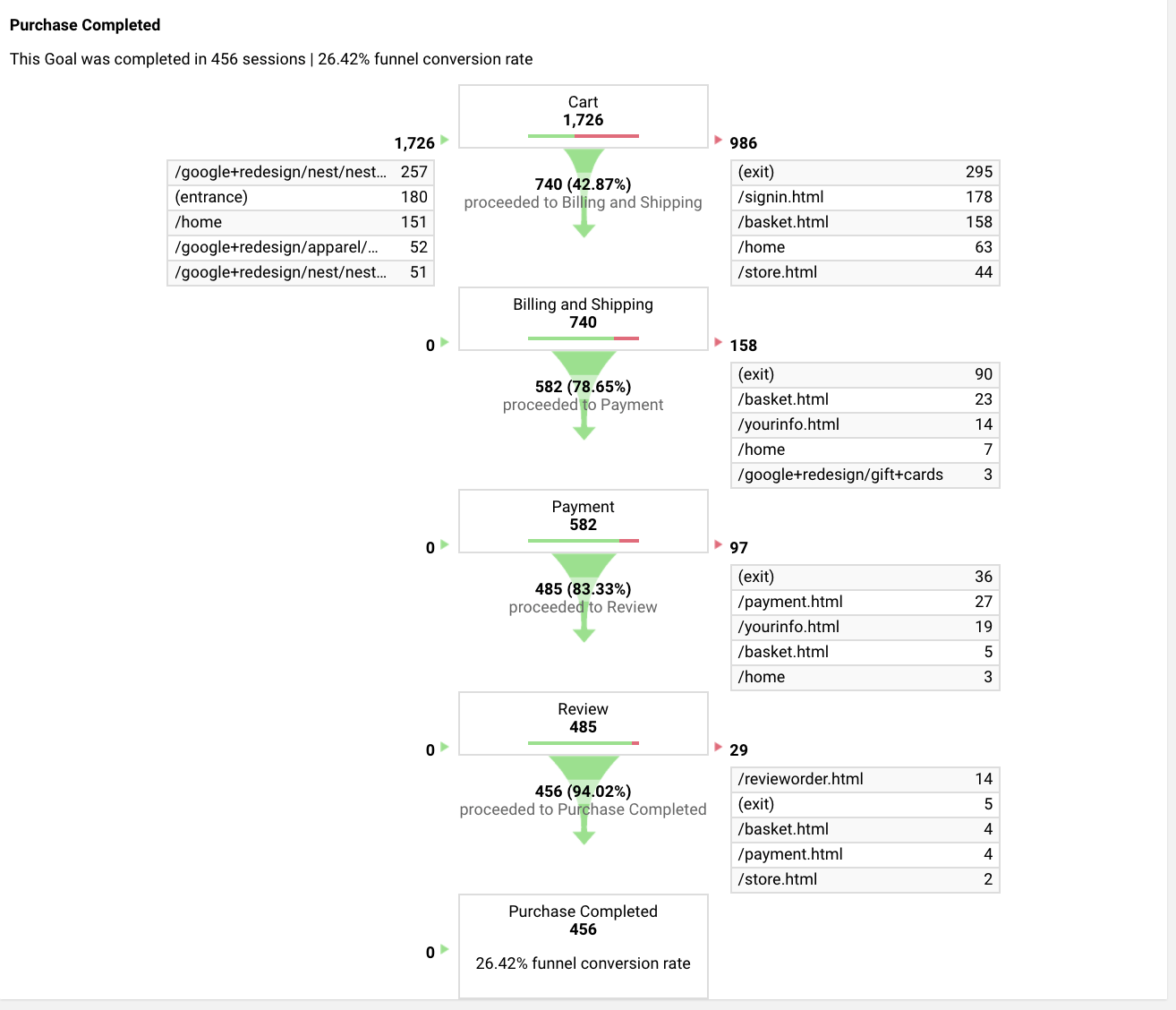
Image source: Medium
Google Analytics allows you to track the funnel drop-off rates, the average time spent on each step, and more. It helps you understand your user journey and optimize sales and marketing funnels.
Tracking funnel metrics in Google Analytics is relatively easy – you must create a GA account and install the tracking code on your website. Then you can set up and customize various goals on your account and define funnel pages. You can start tracking and reporting the performance of your funnel pages right away.
With a few clicks, you'll see which pages are working and which are not – you can check this and visualize the data in the GA conversion report. You can also adjust your funnel to ensure it's leading customers down the right path.
To see how Google Analytics compares to other behavior analytics tools, read the following articles
Google Analytics pros
- Free and easy to set up and use
- Offers a comprehensive view of website data across different devices and platforms
- Includes audience segmentation, funnel analysis, and event tracking
- Integrates with other Google services, such as Google Ads, for campaign tracking
Google Analytics cons
- Data offered by GA is broad, page-level, and statistical.
- You can’t analyze actual user behavior as it lacks session recordings and interactive heatmaps, so you don’t get additional context for the data you collect.
- You can’t use the platform to get customer feedback directly via customer feedback forms or other similar tools.
Of course, Google Analytics isn’t the only option – there are other behavior analytics tools you can use to find drop-offs and optimize your funnels. One such tool is FullSession, our comprehensive product analytics platform that provides in-depth product metrics.
Let’s explain how it works.
How to prevent funnel drop and boost conversion rate with FullSession
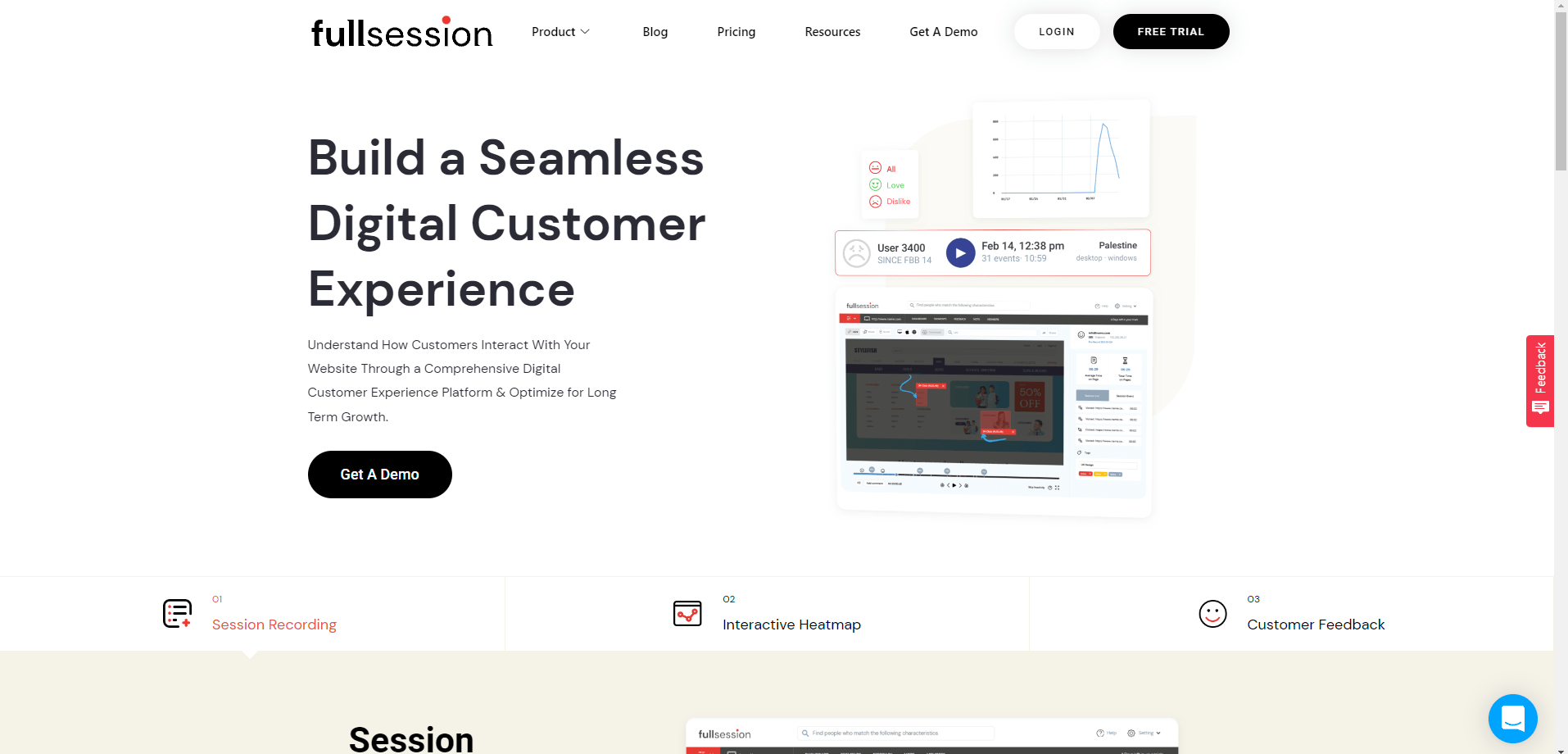
FullSession is a UX analytics tool that helps you prevent funnel drop-offs and optimize your conversion rate.
While it provides crucial page-level data, it primarily focuses on the experience and behavior of your website visitors.
Thanks to features such as funnel and conversion tracking, session recordings and replays, interactive heatmaps, or customer feedback forms, you can understand what motivates your customers and what drives them away from your website, leading to funnel drop-offs.
To see how FullSession works, start a 14-day free trial.
Create a funnel and start with conversion tracking

With FullSession, creating funnels takes minutes. You can easily:
- Define the funnel name
- Set up all steps in the process
- Define event types (clicks, visited pages, or changed inputs)
- Choose a selector or text
- Define operation and value
- Add filters
- Create and save segments
FullSession provides valuable metrics to help you decide on the next steps for improving your results. You can see the number of users, conversion rate, time to convert, and max drop-offs.

You can even track results for each step in the funnel and assess how many visitors achieved your desired action or bounced before completing it.

You can then reevaluate your funnel, assess your steps to adjust your strategy and watch how your conversions increase in real-time.
Understand why users leave your site with session recordings
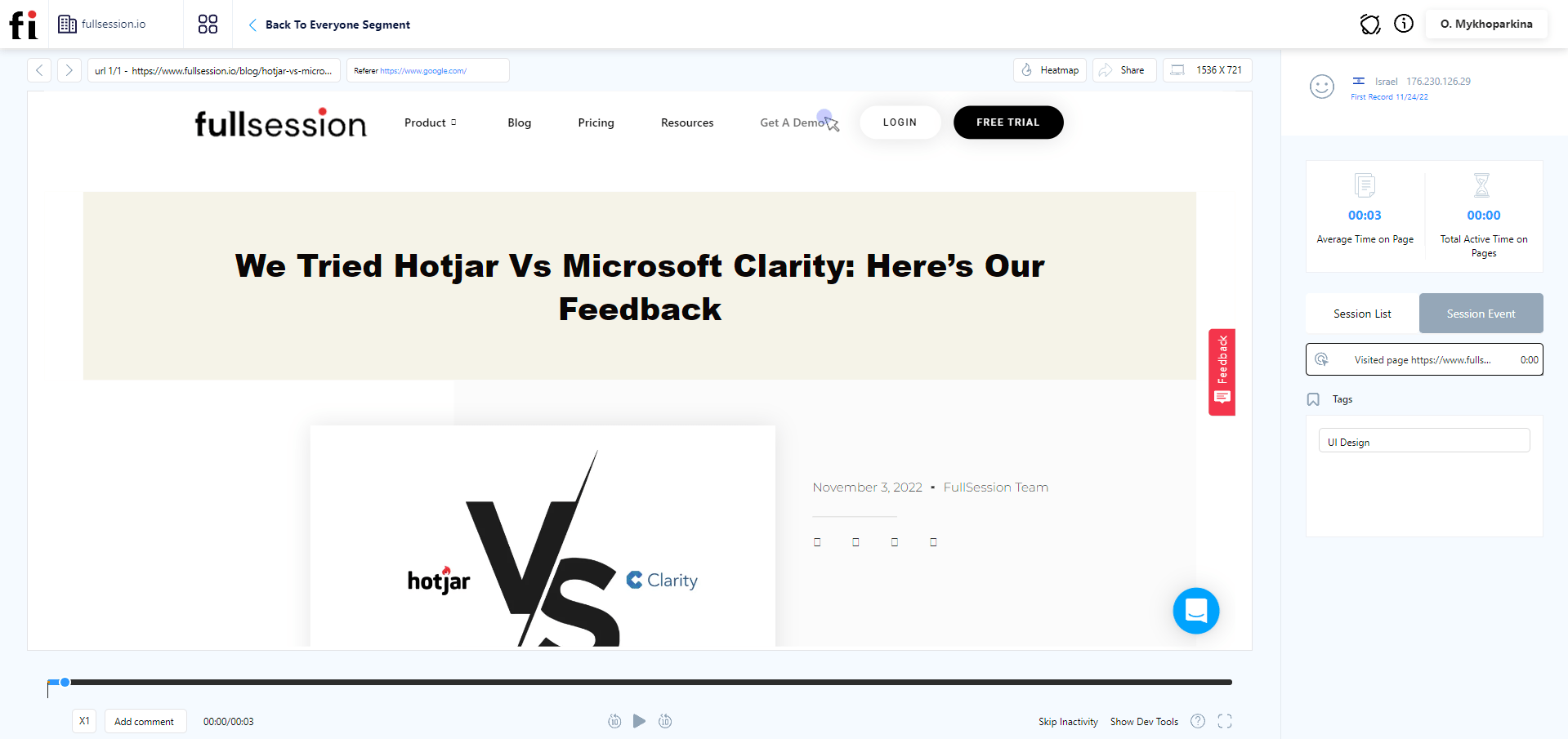
The great thing about FullSession is that you don’t need to evaluate statistical data to understand what’s happening during user sessions. With our website tracking tools, you can get an accurate picture of your funnel issues.
You can watch how people interact with your website via session recordings and replays, observe the problems they encounter and draw your conclusions to make necessary adjustments.
The tool allows you to watch the recordings however you like – pause, rewind, fast forward, and even skip periods of inactivity to save time.
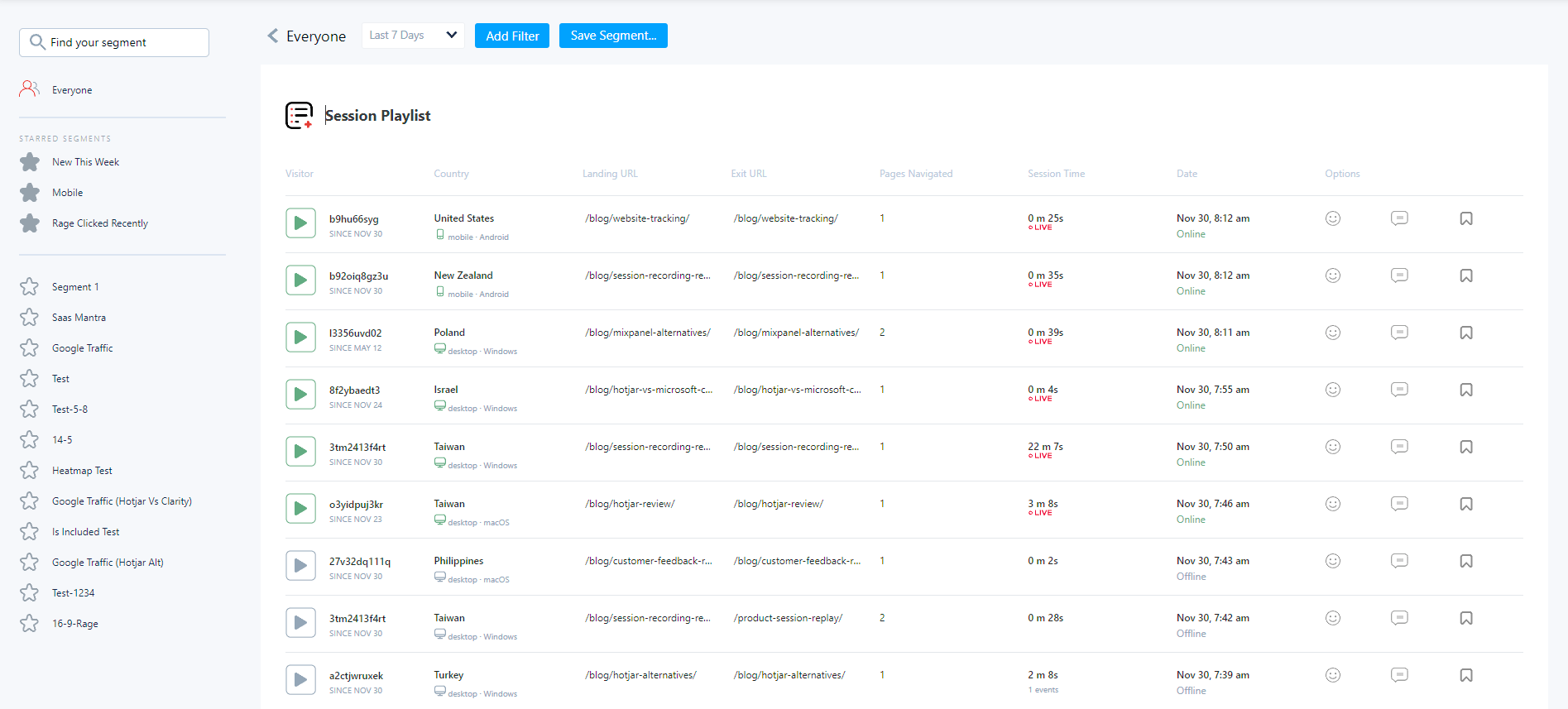
FullSession also provides customer data: their IP address, country, device, operating system, a list of visited pages, average and total time spent on pages, and more.
Monitor how users engage with your site with interactive heatmaps
Session recordings aren’t the only feature you can use for tracking website visitors and collecting data regarding their behavior.
With FullSession, you also have access to website heatmap tools which help you identify issues people face on your website that lead to funnel drop-offs.
FullSession offers three interactive heat maps: click maps for click tracking, cursor maps, and scroll maps. Each of them provides access to slightly different information. Let's share some details.
Click maps
Click maps let you understand what web page elements are not working as intended, so you can fix usability issues and increase customer satisfaction.
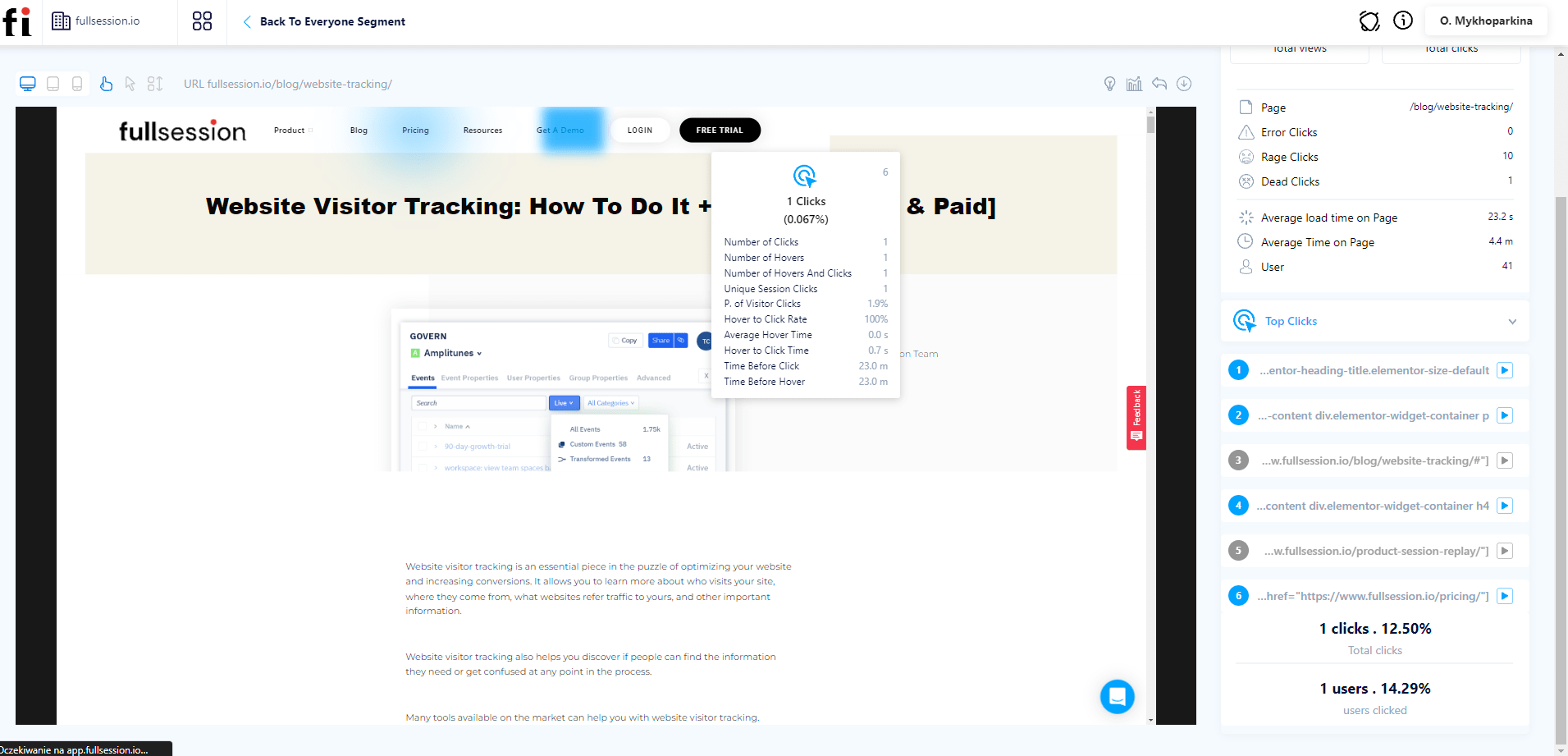
Movement maps
The second type of heatmaps allows you to track the precise movement of the mouse cursor during a given session. You can see what page elements users avoid – the potential cause for a funnel drop.
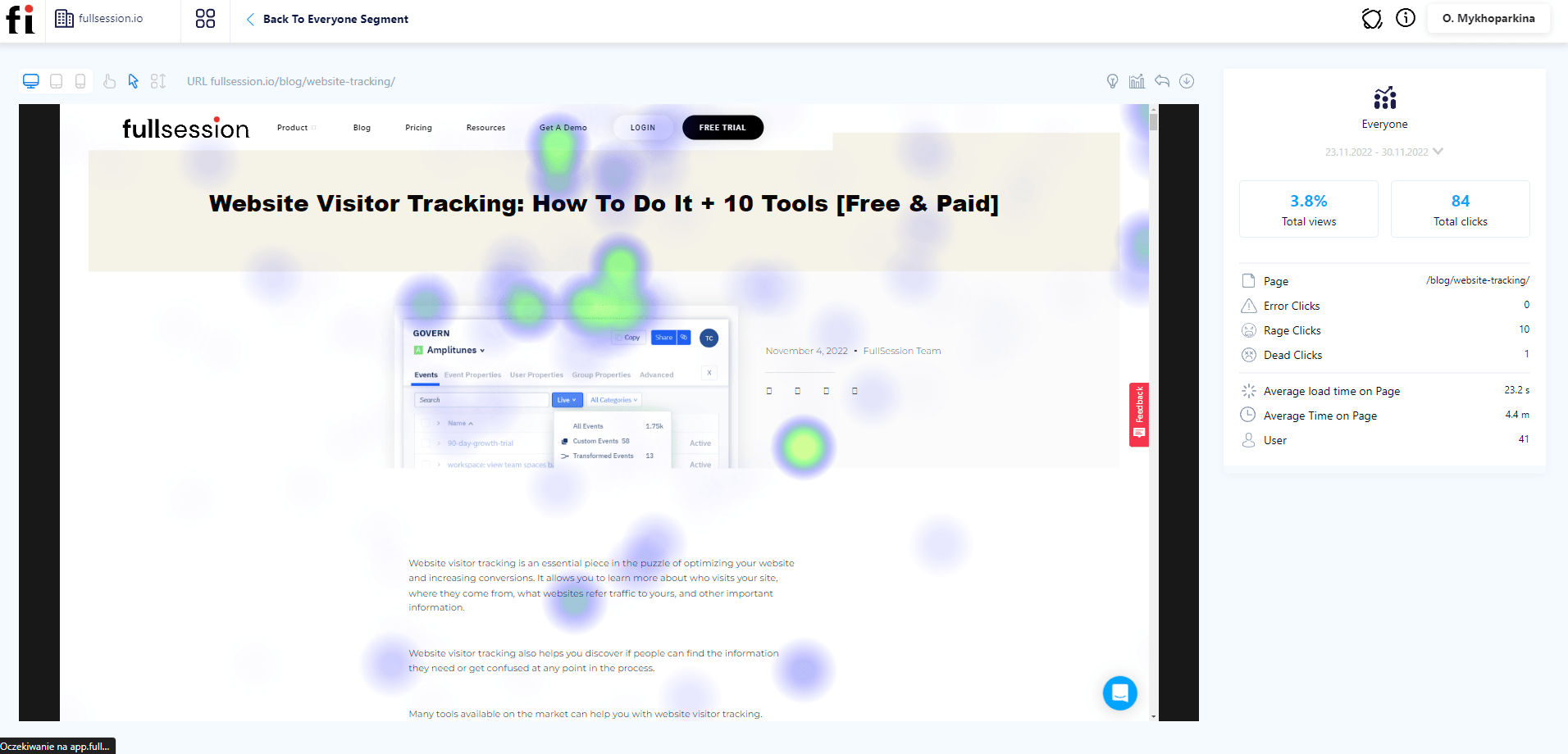
Scroll maps
The third and final heatmap type – scroll maps – lets you know how far a given user scrolls down the page they visited. Pages that are too long can cause people to leave the site. You can also use scroll maps to evaluate the effectiveness of your landing page.
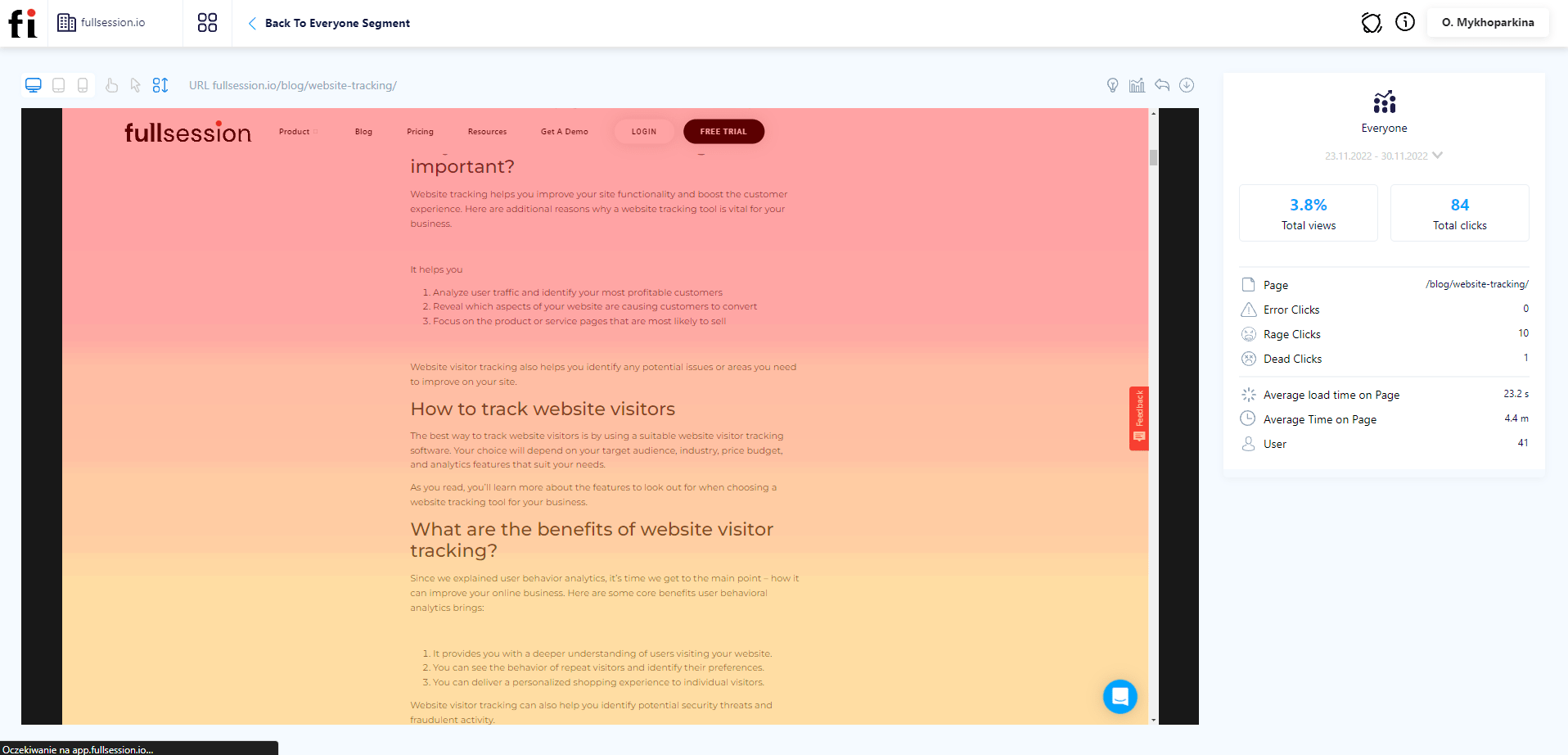
Get insights into customer satisfaction with website feedback forms
Session recordings and interactive heatmaps are great, but users are sometimes the best information source.
FullSession provides customer feedback tools you can use to communicate with your users directly and collect valuable user feedback regarding the issues that cause funnel drops.
You can stay in touch with your customers and better understand their experience with your website as if you used a specialized NPS software platform. You can track all trends in customer feedback reports and watch session recordings connected to each feedback.
It helps you fix problems that negatively affect your conversion rates.
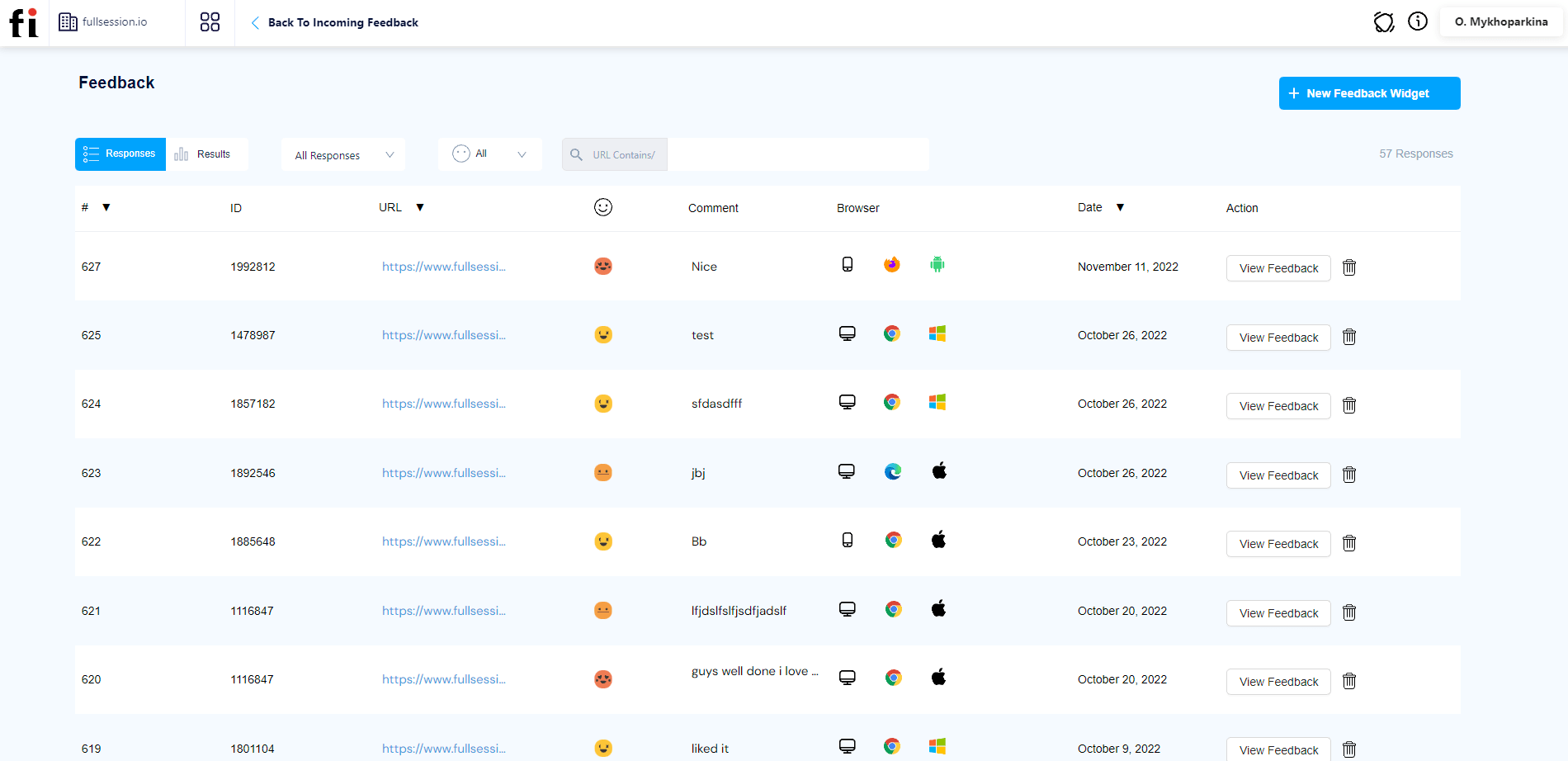
You can ask people to rate their experience and specific changes or features. It provides information that serves as context for what you see on session recordings and the conclusions you draw from our interactive heatmaps.
Our platform helps you understand the entire customer journey.
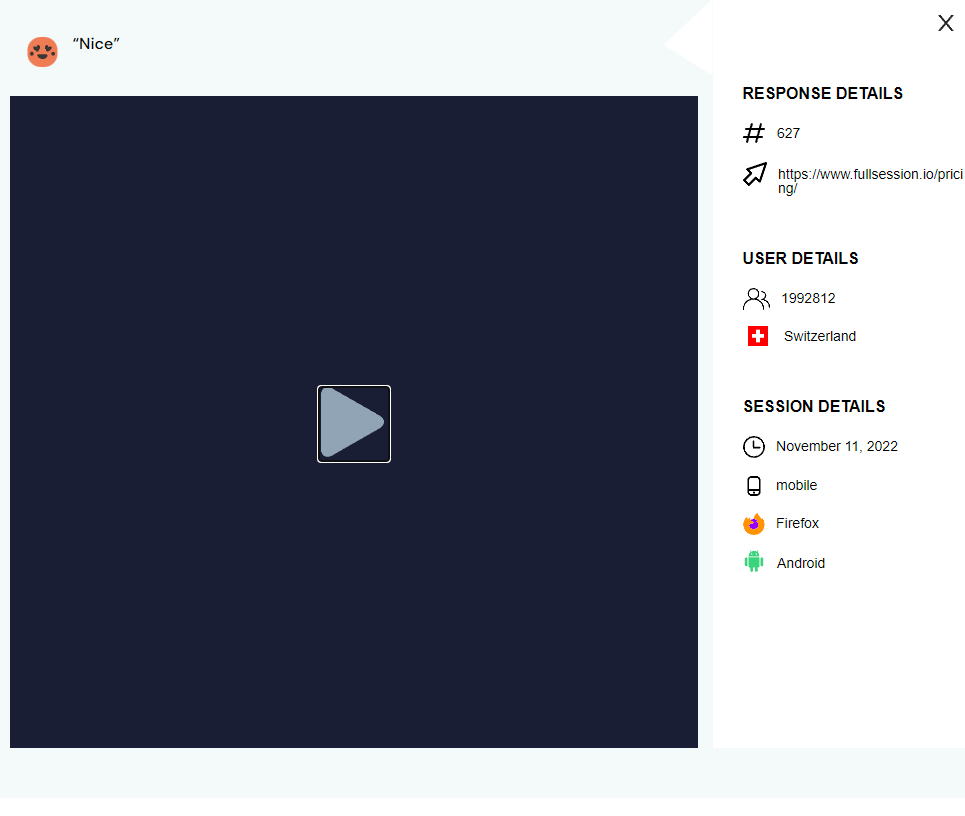
Five reasons to start using FullSession today
Here are some reasons to use FullSession for preventing funnel drops:
- You can track real users – there is no need to spend your budget on hiring testers. You can observe real user interactions to understand what causes funnel drops.
- FullSession doesn’t hinder your website speed– our tool doesn’t affect website performance in any way during data collection and analysis.
- A wealth of tools in one platform – you can access plenty of powerful features: session recordings, heatmaps, customer feedback forms, UTM tracking, and more to optimize your funnels.
- Intuitive interface – FullSession is very easy to set up and use and has a low learning curve.
- Crucial data is easily accessible – thanks to powerful segmentation and filtering options, you can easily find specific sessions, events, and other kinds of data.
Thanks to a robust feature set and intuitive design, FullSession is a great help for businesses that want to understand their users better and improve their conversion rate.
Funnel drop: The bottom line about increasing conversions
Funnel analytics is essential for businesses looking to increase conversions. It helps you identify website areas where you lose customers.
To reap the benefits of your funnel analysis, however, you must optimize your funnels and reduce drop-offs. To do that effectively, you need to collect valuable user behavior data.
FullSession helps you get insights into user behavior via session recordings and replays. Our interactive heatmaps allow you to track user journeys easily.
The customer feedback forms let you collect valuable feedback directly from users, and funnels and conversions let you track customer journeys effortlessly. FullSession also helps you find the data you need in a given moment, thanks to powerful filtering and segmentation features.
Do you want to see our platform in action? Schedule a demo or start a 14-day free trial right now!
FAQs about funnel drop
Here are answers to some common questions regarding funnel drop-offs.
What is a funnel score?
Funnel score is a metric that measures how likely a customer is to convert at each stage of the sales funnel. A funnel drop occurs when a customer drops out of the funnel at a particular stage.
What is the purpose of a step-drop analysis?
A step-drop analysis is a type of funnel analysis used to identify how much effort – how many steps – it takes for a customer to complete the desired action. Tools like Hotjar provide this metric is important because it can help businesses identify areas where they may lose customers.
How do you measure a funnel drop-off?
There are a few different ways to measure a funnel drop-off. The most common is to track the number of leads or potential customers who enter the funnel – usually through a form on your website – and the number of leads or customers who exit the funnel at each stage.
